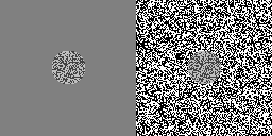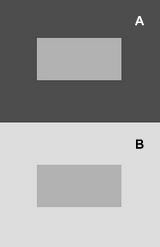Loading AI tools
The Chubb illusion is an optical illusion wherein the apparent contrast of an object varies dramatically, depending on the context of the presentation.[1] Low-contrast texture surrounded by a uniform field appears to have higher contrast than when it is surrounded by high-contrast texture. This was observed and documented by Charles Chubb and colleagues in 1989.[2] An empirical explanation of the Chubb illusion was elucidated by Lotto and Purves in 2001.[1]


For a patch of random texture embedded in a surrounding background of similar texture, Chubb et al. (1989) demonstrate that perceived contrast of the texture patch depends significantly on the background contrast.[2] A more “traditional” illusion, such as the Contrast effect, demonstrates that perceived lightness of a uniformly luminant form on a large uniform background depends of the ratio of form luminance to background luminance.[3] This phenomenon, known as simultaneous contrast, is evinced in Figure 2; here, the ratio of the top rectangle’s luminance (A) to background luminance is greater than 1, while it is less than 1 in the bottom rectangle (B).[2] Lateral inhibition, a concept that seeks to explain simultaneous contrast, suggests that neurons strongly stimulated by the background of B suppress the less strongly stimulated neurons of the interior rectangle.[2] In A, there is no such inhibition. However, the fact that both A and B appear of "uniform lightness across their expanse" suggests that the process of lateral inhibition is more complex than previously thought.[4] Chubb et al. (1989) assert that the principle of lateral inhibition rests on the assumption that the determining factor of perceived lightness rests in the ratio, at the rectangle edge, of rectangle luminance to background luminance.[2] The Chubb illusion seems to go beyond the scope of this model– here, experimenters varied the contrast of a visual texture. The zero-luminance background of Figure 2 (A) becomes a zero-contrast field in the analogous portion of Figure 1, while the high-luminance field of Figure 2 (B) becomes a high-contrast texture field likewise [2] Observers empirically perceive the texture disk of the leftmost portion of Figure 1 as having higher contrast than the disk on the right, even though the two are the same.[2] After conducting experiments on contrast and lightness induction, interocular induction, and induction between spatial frequency bands, Chubb et al (1989) support "a model in which the output gain of such a band-selective neuron is normalized relative to the average response amplitude of nearby neurons with the same frequency tuning." [2]

Lotto and Purves (2001) demonstrate that the Chubb illusion can be explained "by the degree to which imperfect transmittance is likely to have affected the light that reaches the eye." [1] Indeed, these observations suggest a wholly empirical explanation of the Chubb illusion.[5] Lotto and Purves (2001) suggest that general illusory percepts of brightness are typically explained as consequences of lateral inhibition.[2][6] If this is the case, the perceived difference in in brightness of target elements in Figure 3 (A) is largely unaffected by the surround in Figure 3 (C), which exhibits lower spatial contrast than the target.[1] This is indeed what is empirically observed. However, despite this fact, Lotto and Purves (2001) assert that "this reasoning is reasoning is undermined by the fact that the apparent contrast by the target pattern in Figure 3 (D) is mostly unaffected by the surround of Figure 3 (F)." [1] Herein lies the motivation for Lotto and Purves (2001) to examine the Chubb illusion in 'wholly empirical' terms– mainly as a consequence of past experience, or in this case, the influence of transmittance on ambiguous stimuli.[1]
Imperfect Transmittance
The common denominator of the observations reported by Lotto and Purves (2001) lies in the empirical consequences of imperfect transmittance.[1] This effect allows observers to experience a reduced difference in spectral contrast or luminance from object surfaces.[1][7] All objects on Earth's surface are observed via some element of imperfect transmittance– viewing objects from a distance, in smog or fog, or through a semitransparent medium greatly affects the amount of light that reaches the eye.[1] In some cases, the luminance of two target surfaces can be reduced, as Lotto and Purves (2001) demonstrate, from a ratio of 8:3 to approximately 7:5.[1] If perception is generated empirically, then "the extent that a stimulus is consistent with imperfect transmittance... will be incorporated into the perception of the target."[1] The Chubb stimulus in Figure 1 (B) is consistent with a contribution of transmittance for two reasons: the patterned elements of the surround are continuous with the patterned elements of the target, and the luminances of the target elements accord with the values that would arise is the surround pattern were viewed through an imperfectly transmitting medium.[1] This explanation of the Chubb illusion insinuates that changing the stimulus in Figure 1 (B) in a way that makes it less consistant with being viewed through an imperfectly transmitting medium should decrease, or reverse, this effect.[1] Indeed, this is what is demonstrated. This observation contrasts the explanation of the Chubb illusion as resulting from lateral inhibitory processes; if this interpretation were valid, then altering luminance, motion, or spectral distribution of the target surround would not alter the percept [1] The empirical findings by Lotto and Purves (2001) also contrast with the hypothesized 'illusions of brightness' caused by contour junctions in the stimulus proposed by Anderson (1997).[1][8]
Wikiwand in your browser!
Seamless Wikipedia browsing. On steroids.
Every time you click a link to Wikipedia, Wiktionary or Wikiquote in your browser's search results, it will show the modern Wikiwand interface.
Wikiwand extension is a five stars, simple, with minimum permission required to keep your browsing private, safe and transparent.
